Nursing Role in Program Design and Implementation Report
VerifiedAdded on 2022/08/20
|11
|2725
|25
Report
AI Summary
This report delves into the multifaceted role of nurses in healthcare program design and implementation, emphasizing their significance in advocating for policy changes and ensuring quality patient care. It highlights the various responsibilities nurses undertake, including clinical practice, patient education, and community outreach. The report discusses strategies for nurses to engage in advocacy and policy development, such as practice facilitation, revision of professional roles, and fostering a supportive organizational culture. It also examines the contributions of nurses in program design, including needs assessment, resource mobilization, and the identification of relevant health policies. Through a case study of a community-based education program, the report illustrates the nurses' involvement in assessing community needs, identifying suitable interventions, and advocating for policy adherence. Additionally, it explores the importance of interdisciplinary teams in healthcare program implementation, emphasizing nurses' role in coordinating care and promoting collaboration. The report concludes by highlighting the efforts of organizations like the American Nurses Association in empowering nurses to advocate for policy changes and improve healthcare outcomes.
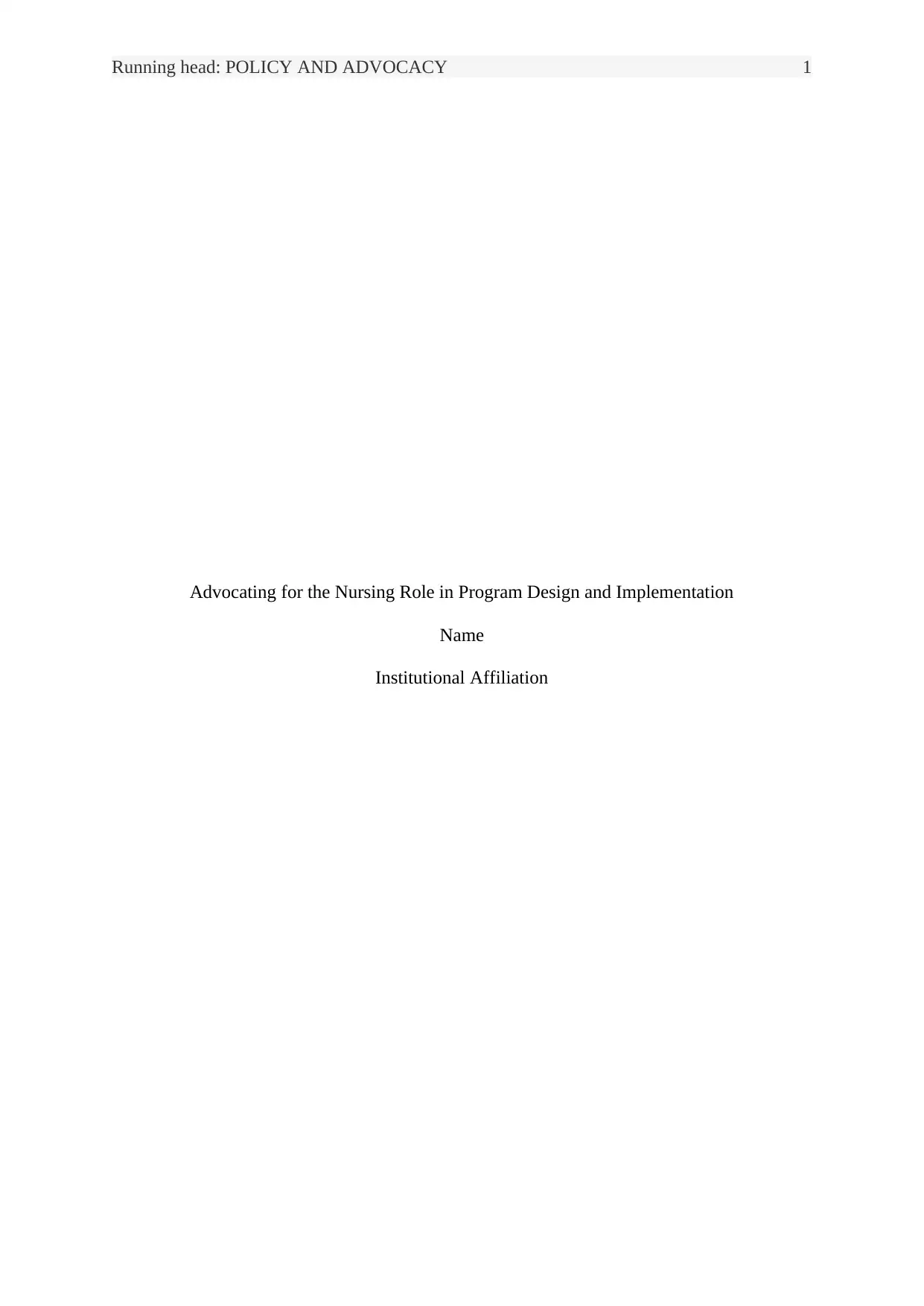
Running head: POLICY AND ADVOCACY 1
Advocating for the Nursing Role in Program Design and Implementation
Name
Institutional Affiliation
Advocating for the Nursing Role in Program Design and Implementation
Name
Institutional Affiliation
Paraphrase This Document
Need a fresh take? Get an instant paraphrase of this document with our AI Paraphraser
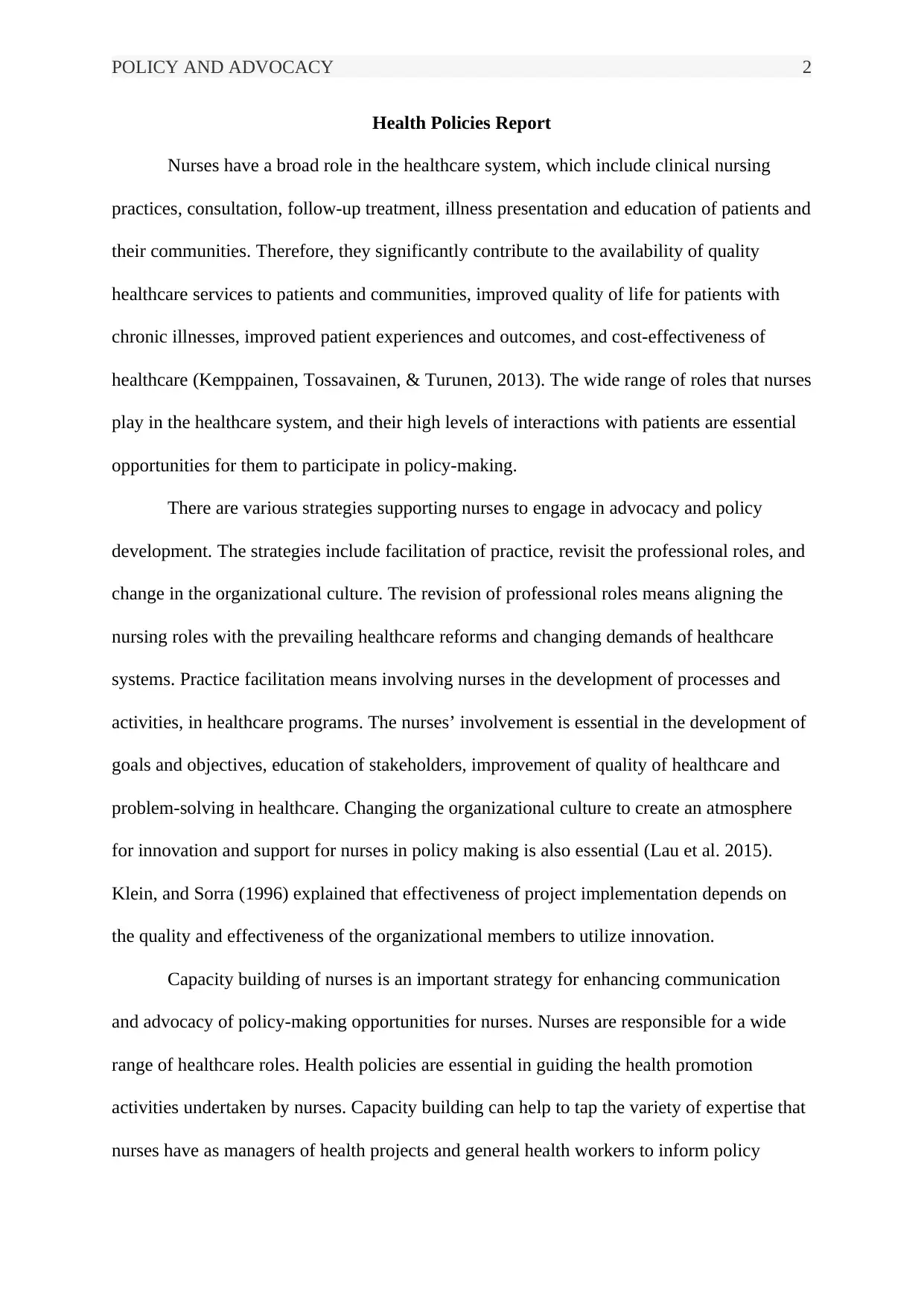
POLICY AND ADVOCACY 2
Health Policies Report
Nurses have a broad role in the healthcare system, which include clinical nursing
practices, consultation, follow-up treatment, illness presentation and education of patients and
their communities. Therefore, they significantly contribute to the availability of quality
healthcare services to patients and communities, improved quality of life for patients with
chronic illnesses, improved patient experiences and outcomes, and cost-effectiveness of
healthcare (Kemppainen, Tossavainen, & Turunen, 2013). The wide range of roles that nurses
play in the healthcare system, and their high levels of interactions with patients are essential
opportunities for them to participate in policy-making.
There are various strategies supporting nurses to engage in advocacy and policy
development. The strategies include facilitation of practice, revisit the professional roles, and
change in the organizational culture. The revision of professional roles means aligning the
nursing roles with the prevailing healthcare reforms and changing demands of healthcare
systems. Practice facilitation means involving nurses in the development of processes and
activities, in healthcare programs. The nurses’ involvement is essential in the development of
goals and objectives, education of stakeholders, improvement of quality of healthcare and
problem-solving in healthcare. Changing the organizational culture to create an atmosphere
for innovation and support for nurses in policy making is also essential (Lau et al. 2015).
Klein, and Sorra (1996) explained that effectiveness of project implementation depends on
the quality and effectiveness of the organizational members to utilize innovation.
Capacity building of nurses is an important strategy for enhancing communication
and advocacy of policy-making opportunities for nurses. Nurses are responsible for a wide
range of healthcare roles. Health policies are essential in guiding the health promotion
activities undertaken by nurses. Capacity building can help to tap the variety of expertise that
nurses have as managers of health projects and general health workers to inform policy
Health Policies Report
Nurses have a broad role in the healthcare system, which include clinical nursing
practices, consultation, follow-up treatment, illness presentation and education of patients and
their communities. Therefore, they significantly contribute to the availability of quality
healthcare services to patients and communities, improved quality of life for patients with
chronic illnesses, improved patient experiences and outcomes, and cost-effectiveness of
healthcare (Kemppainen, Tossavainen, & Turunen, 2013). The wide range of roles that nurses
play in the healthcare system, and their high levels of interactions with patients are essential
opportunities for them to participate in policy-making.
There are various strategies supporting nurses to engage in advocacy and policy
development. The strategies include facilitation of practice, revisit the professional roles, and
change in the organizational culture. The revision of professional roles means aligning the
nursing roles with the prevailing healthcare reforms and changing demands of healthcare
systems. Practice facilitation means involving nurses in the development of processes and
activities, in healthcare programs. The nurses’ involvement is essential in the development of
goals and objectives, education of stakeholders, improvement of quality of healthcare and
problem-solving in healthcare. Changing the organizational culture to create an atmosphere
for innovation and support for nurses in policy making is also essential (Lau et al. 2015).
Klein, and Sorra (1996) explained that effectiveness of project implementation depends on
the quality and effectiveness of the organizational members to utilize innovation.
Capacity building of nurses is an important strategy for enhancing communication
and advocacy of policy-making opportunities for nurses. Nurses are responsible for a wide
range of healthcare roles. Health policies are essential in guiding the health promotion
activities undertaken by nurses. Capacity building can help to tap the variety of expertise that
nurses have as managers of health projects and general health workers to inform policy
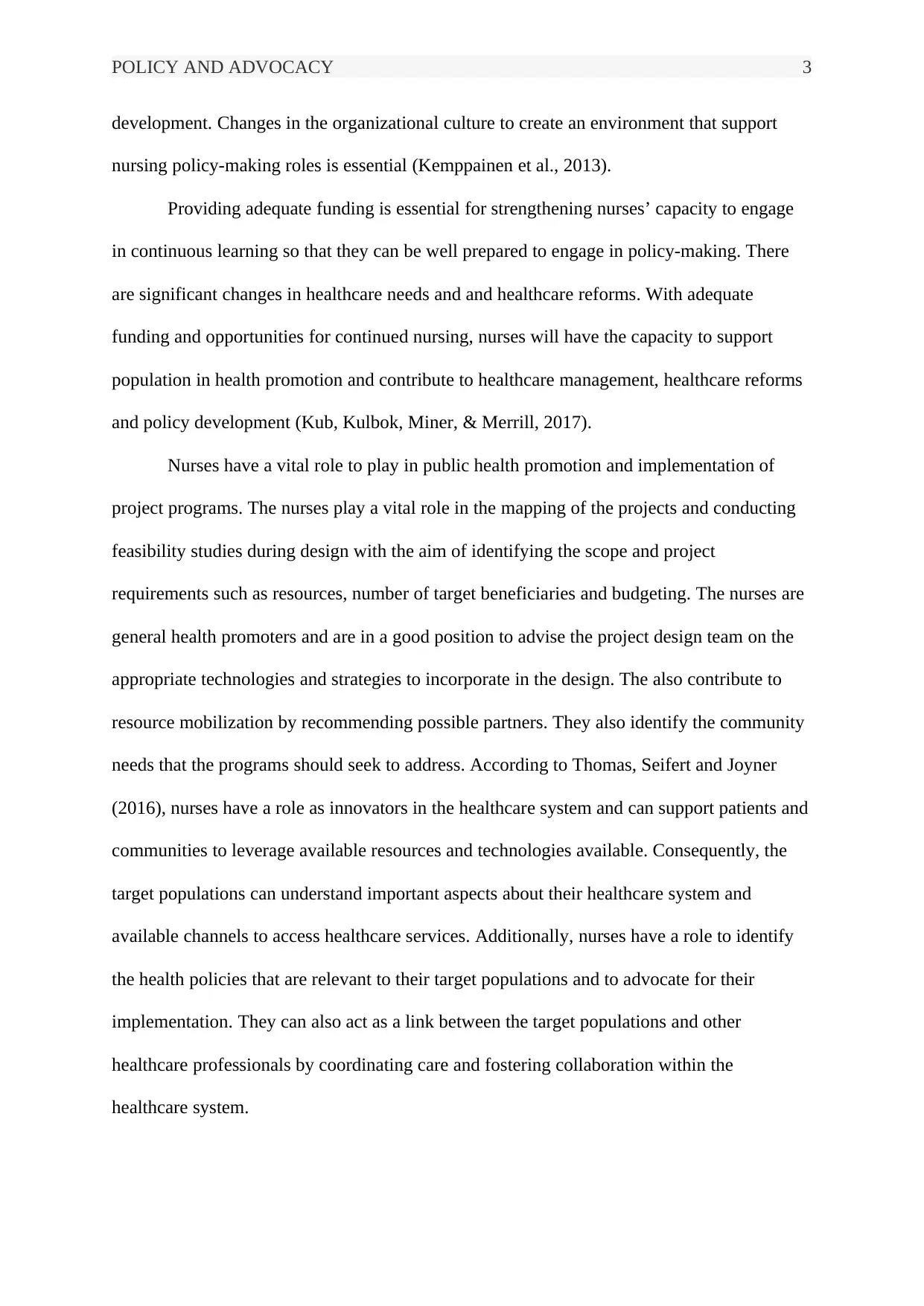
POLICY AND ADVOCACY 3
development. Changes in the organizational culture to create an environment that support
nursing policy-making roles is essential (Kemppainen et al., 2013).
Providing adequate funding is essential for strengthening nurses’ capacity to engage
in continuous learning so that they can be well prepared to engage in policy-making. There
are significant changes in healthcare needs and and healthcare reforms. With adequate
funding and opportunities for continued nursing, nurses will have the capacity to support
population in health promotion and contribute to healthcare management, healthcare reforms
and policy development (Kub, Kulbok, Miner, & Merrill, 2017).
Nurses have a vital role to play in public health promotion and implementation of
project programs. The nurses play a vital role in the mapping of the projects and conducting
feasibility studies during design with the aim of identifying the scope and project
requirements such as resources, number of target beneficiaries and budgeting. The nurses are
general health promoters and are in a good position to advise the project design team on the
appropriate technologies and strategies to incorporate in the design. The also contribute to
resource mobilization by recommending possible partners. They also identify the community
needs that the programs should seek to address. According to Thomas, Seifert and Joyner
(2016), nurses have a role as innovators in the healthcare system and can support patients and
communities to leverage available resources and technologies available. Consequently, the
target populations can understand important aspects about their healthcare system and
available channels to access healthcare services. Additionally, nurses have a role to identify
the health policies that are relevant to their target populations and to advocate for their
implementation. They can also act as a link between the target populations and other
healthcare professionals by coordinating care and fostering collaboration within the
healthcare system.
development. Changes in the organizational culture to create an environment that support
nursing policy-making roles is essential (Kemppainen et al., 2013).
Providing adequate funding is essential for strengthening nurses’ capacity to engage
in continuous learning so that they can be well prepared to engage in policy-making. There
are significant changes in healthcare needs and and healthcare reforms. With adequate
funding and opportunities for continued nursing, nurses will have the capacity to support
population in health promotion and contribute to healthcare management, healthcare reforms
and policy development (Kub, Kulbok, Miner, & Merrill, 2017).
Nurses have a vital role to play in public health promotion and implementation of
project programs. The nurses play a vital role in the mapping of the projects and conducting
feasibility studies during design with the aim of identifying the scope and project
requirements such as resources, number of target beneficiaries and budgeting. The nurses are
general health promoters and are in a good position to advise the project design team on the
appropriate technologies and strategies to incorporate in the design. The also contribute to
resource mobilization by recommending possible partners. They also identify the community
needs that the programs should seek to address. According to Thomas, Seifert and Joyner
(2016), nurses have a role as innovators in the healthcare system and can support patients and
communities to leverage available resources and technologies available. Consequently, the
target populations can understand important aspects about their healthcare system and
available channels to access healthcare services. Additionally, nurses have a role to identify
the health policies that are relevant to their target populations and to advocate for their
implementation. They can also act as a link between the target populations and other
healthcare professionals by coordinating care and fostering collaboration within the
healthcare system.
⊘ This is a preview!⊘
Do you want full access?
Subscribe today to unlock all pages.

Trusted by 1+ million students worldwide
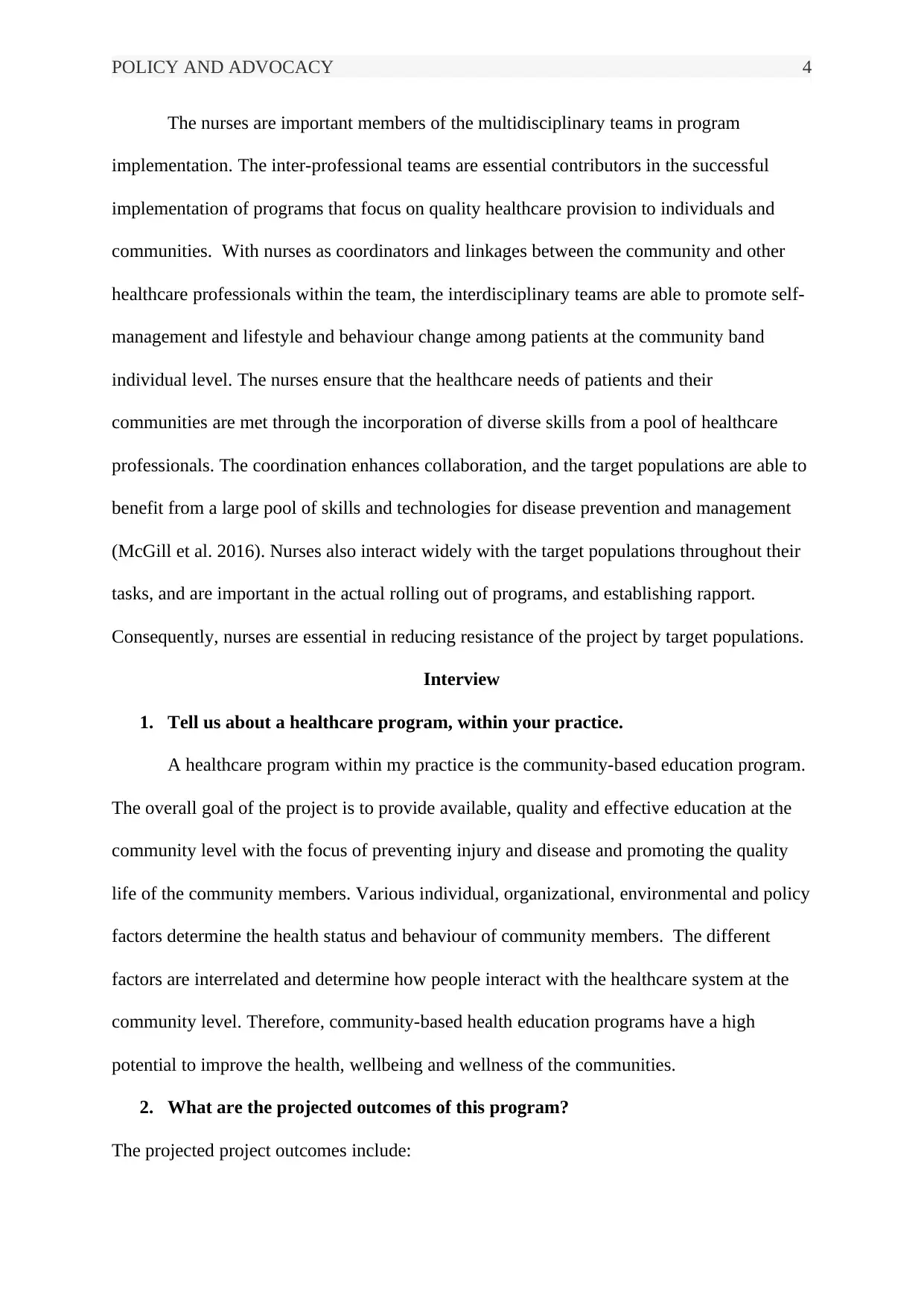
POLICY AND ADVOCACY 4
The nurses are important members of the multidisciplinary teams in program
implementation. The inter-professional teams are essential contributors in the successful
implementation of programs that focus on quality healthcare provision to individuals and
communities. With nurses as coordinators and linkages between the community and other
healthcare professionals within the team, the interdisciplinary teams are able to promote self-
management and lifestyle and behaviour change among patients at the community band
individual level. The nurses ensure that the healthcare needs of patients and their
communities are met through the incorporation of diverse skills from a pool of healthcare
professionals. The coordination enhances collaboration, and the target populations are able to
benefit from a large pool of skills and technologies for disease prevention and management
(McGill et al. 2016). Nurses also interact widely with the target populations throughout their
tasks, and are important in the actual rolling out of programs, and establishing rapport.
Consequently, nurses are essential in reducing resistance of the project by target populations.
Interview
1. Tell us about a healthcare program, within your practice.
A healthcare program within my practice is the community-based education program.
The overall goal of the project is to provide available, quality and effective education at the
community level with the focus of preventing injury and disease and promoting the quality
life of the community members. Various individual, organizational, environmental and policy
factors determine the health status and behaviour of community members. The different
factors are interrelated and determine how people interact with the healthcare system at the
community level. Therefore, community-based health education programs have a high
potential to improve the health, wellbeing and wellness of the communities.
2. What are the projected outcomes of this program?
The projected project outcomes include:
The nurses are important members of the multidisciplinary teams in program
implementation. The inter-professional teams are essential contributors in the successful
implementation of programs that focus on quality healthcare provision to individuals and
communities. With nurses as coordinators and linkages between the community and other
healthcare professionals within the team, the interdisciplinary teams are able to promote self-
management and lifestyle and behaviour change among patients at the community band
individual level. The nurses ensure that the healthcare needs of patients and their
communities are met through the incorporation of diverse skills from a pool of healthcare
professionals. The coordination enhances collaboration, and the target populations are able to
benefit from a large pool of skills and technologies for disease prevention and management
(McGill et al. 2016). Nurses also interact widely with the target populations throughout their
tasks, and are important in the actual rolling out of programs, and establishing rapport.
Consequently, nurses are essential in reducing resistance of the project by target populations.
Interview
1. Tell us about a healthcare program, within your practice.
A healthcare program within my practice is the community-based education program.
The overall goal of the project is to provide available, quality and effective education at the
community level with the focus of preventing injury and disease and promoting the quality
life of the community members. Various individual, organizational, environmental and policy
factors determine the health status and behaviour of community members. The different
factors are interrelated and determine how people interact with the healthcare system at the
community level. Therefore, community-based health education programs have a high
potential to improve the health, wellbeing and wellness of the communities.
2. What are the projected outcomes of this program?
The projected project outcomes include:
Paraphrase This Document
Need a fresh take? Get an instant paraphrase of this document with our AI Paraphraser
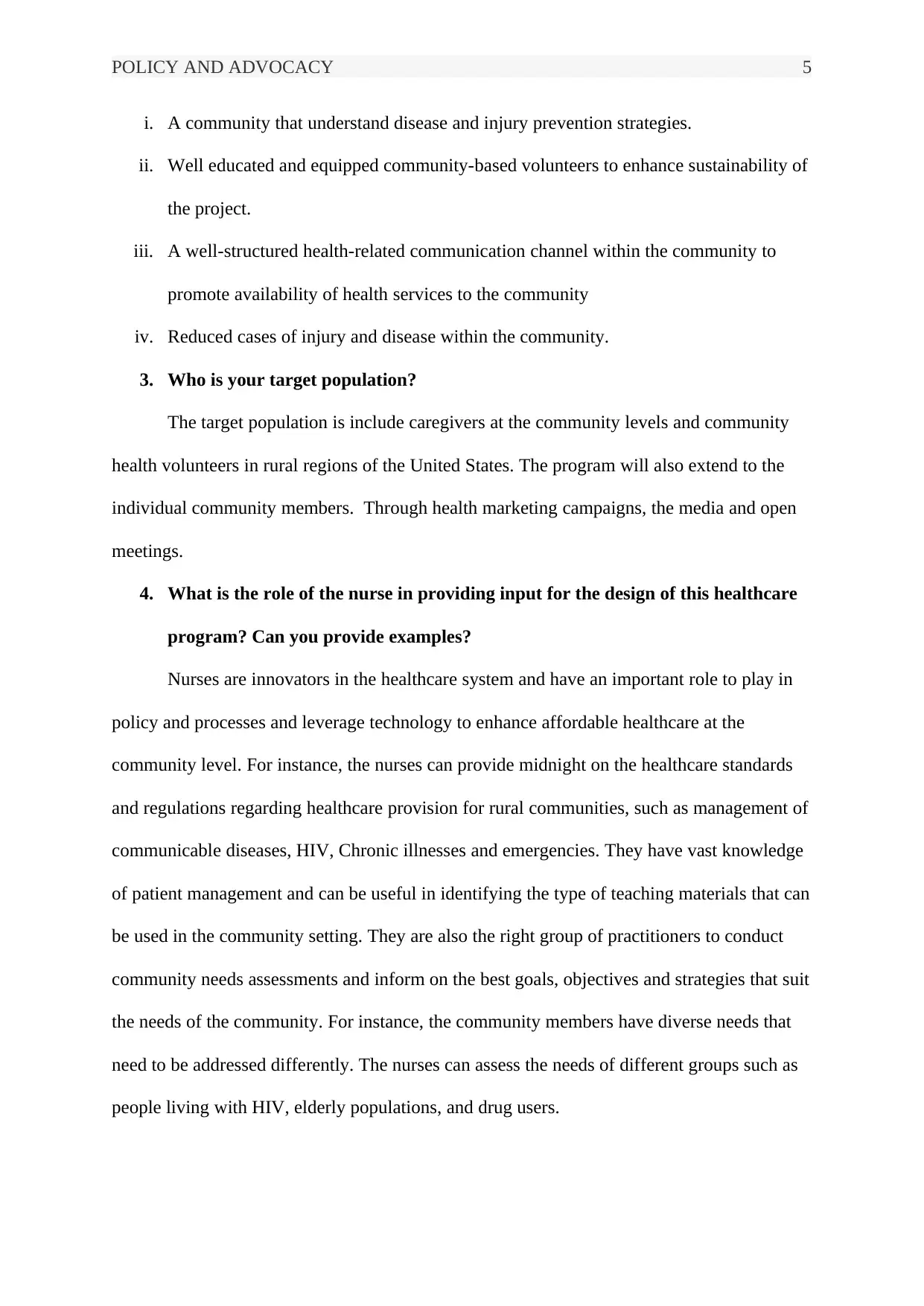
POLICY AND ADVOCACY 5
i. A community that understand disease and injury prevention strategies.
ii. Well educated and equipped community-based volunteers to enhance sustainability of
the project.
iii. A well-structured health-related communication channel within the community to
promote availability of health services to the community
iv. Reduced cases of injury and disease within the community.
3. Who is your target population?
The target population is include caregivers at the community levels and community
health volunteers in rural regions of the United States. The program will also extend to the
individual community members. Through health marketing campaigns, the media and open
meetings.
4. What is the role of the nurse in providing input for the design of this healthcare
program? Can you provide examples?
Nurses are innovators in the healthcare system and have an important role to play in
policy and processes and leverage technology to enhance affordable healthcare at the
community level. For instance, the nurses can provide midnight on the healthcare standards
and regulations regarding healthcare provision for rural communities, such as management of
communicable diseases, HIV, Chronic illnesses and emergencies. They have vast knowledge
of patient management and can be useful in identifying the type of teaching materials that can
be used in the community setting. They are also the right group of practitioners to conduct
community needs assessments and inform on the best goals, objectives and strategies that suit
the needs of the community. For instance, the community members have diverse needs that
need to be addressed differently. The nurses can assess the needs of different groups such as
people living with HIV, elderly populations, and drug users.
i. A community that understand disease and injury prevention strategies.
ii. Well educated and equipped community-based volunteers to enhance sustainability of
the project.
iii. A well-structured health-related communication channel within the community to
promote availability of health services to the community
iv. Reduced cases of injury and disease within the community.
3. Who is your target population?
The target population is include caregivers at the community levels and community
health volunteers in rural regions of the United States. The program will also extend to the
individual community members. Through health marketing campaigns, the media and open
meetings.
4. What is the role of the nurse in providing input for the design of this healthcare
program? Can you provide examples?
Nurses are innovators in the healthcare system and have an important role to play in
policy and processes and leverage technology to enhance affordable healthcare at the
community level. For instance, the nurses can provide midnight on the healthcare standards
and regulations regarding healthcare provision for rural communities, such as management of
communicable diseases, HIV, Chronic illnesses and emergencies. They have vast knowledge
of patient management and can be useful in identifying the type of teaching materials that can
be used in the community setting. They are also the right group of practitioners to conduct
community needs assessments and inform on the best goals, objectives and strategies that suit
the needs of the community. For instance, the community members have diverse needs that
need to be addressed differently. The nurses can assess the needs of different groups such as
people living with HIV, elderly populations, and drug users.
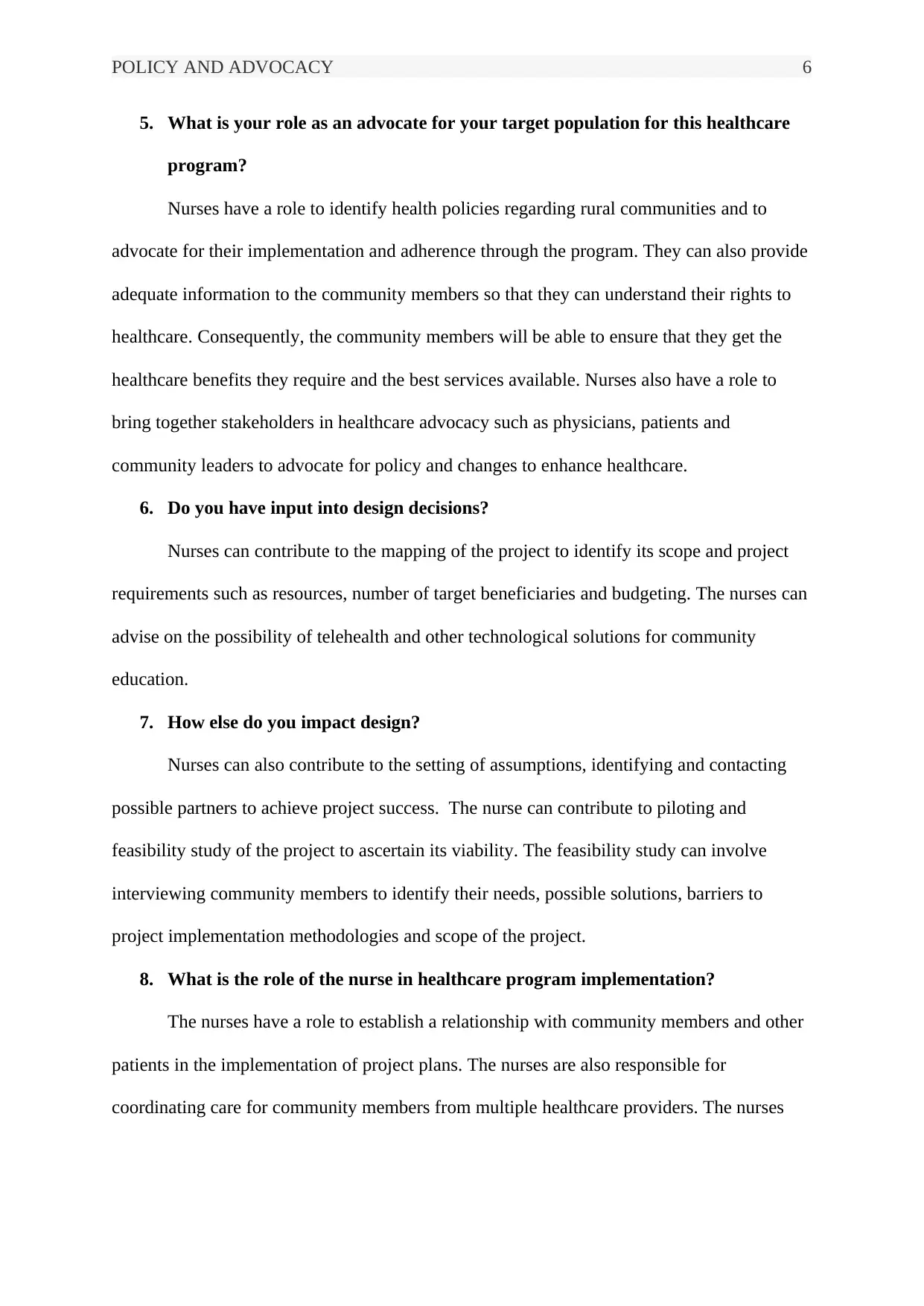
POLICY AND ADVOCACY 6
5. What is your role as an advocate for your target population for this healthcare
program?
Nurses have a role to identify health policies regarding rural communities and to
advocate for their implementation and adherence through the program. They can also provide
adequate information to the community members so that they can understand their rights to
healthcare. Consequently, the community members will be able to ensure that they get the
healthcare benefits they require and the best services available. Nurses also have a role to
bring together stakeholders in healthcare advocacy such as physicians, patients and
community leaders to advocate for policy and changes to enhance healthcare.
6. Do you have input into design decisions?
Nurses can contribute to the mapping of the project to identify its scope and project
requirements such as resources, number of target beneficiaries and budgeting. The nurses can
advise on the possibility of telehealth and other technological solutions for community
education.
7. How else do you impact design?
Nurses can also contribute to the setting of assumptions, identifying and contacting
possible partners to achieve project success. The nurse can contribute to piloting and
feasibility study of the project to ascertain its viability. The feasibility study can involve
interviewing community members to identify their needs, possible solutions, barriers to
project implementation methodologies and scope of the project.
8. What is the role of the nurse in healthcare program implementation?
The nurses have a role to establish a relationship with community members and other
patients in the implementation of project plans. The nurses are also responsible for
coordinating care for community members from multiple healthcare providers. The nurses
5. What is your role as an advocate for your target population for this healthcare
program?
Nurses have a role to identify health policies regarding rural communities and to
advocate for their implementation and adherence through the program. They can also provide
adequate information to the community members so that they can understand their rights to
healthcare. Consequently, the community members will be able to ensure that they get the
healthcare benefits they require and the best services available. Nurses also have a role to
bring together stakeholders in healthcare advocacy such as physicians, patients and
community leaders to advocate for policy and changes to enhance healthcare.
6. Do you have input into design decisions?
Nurses can contribute to the mapping of the project to identify its scope and project
requirements such as resources, number of target beneficiaries and budgeting. The nurses can
advise on the possibility of telehealth and other technological solutions for community
education.
7. How else do you impact design?
Nurses can also contribute to the setting of assumptions, identifying and contacting
possible partners to achieve project success. The nurse can contribute to piloting and
feasibility study of the project to ascertain its viability. The feasibility study can involve
interviewing community members to identify their needs, possible solutions, barriers to
project implementation methodologies and scope of the project.
8. What is the role of the nurse in healthcare program implementation?
The nurses have a role to establish a relationship with community members and other
patients in the implementation of project plans. The nurses are also responsible for
coordinating care for community members from multiple healthcare providers. The nurses
⊘ This is a preview!⊘
Do you want full access?
Subscribe today to unlock all pages.

Trusted by 1+ million students worldwide
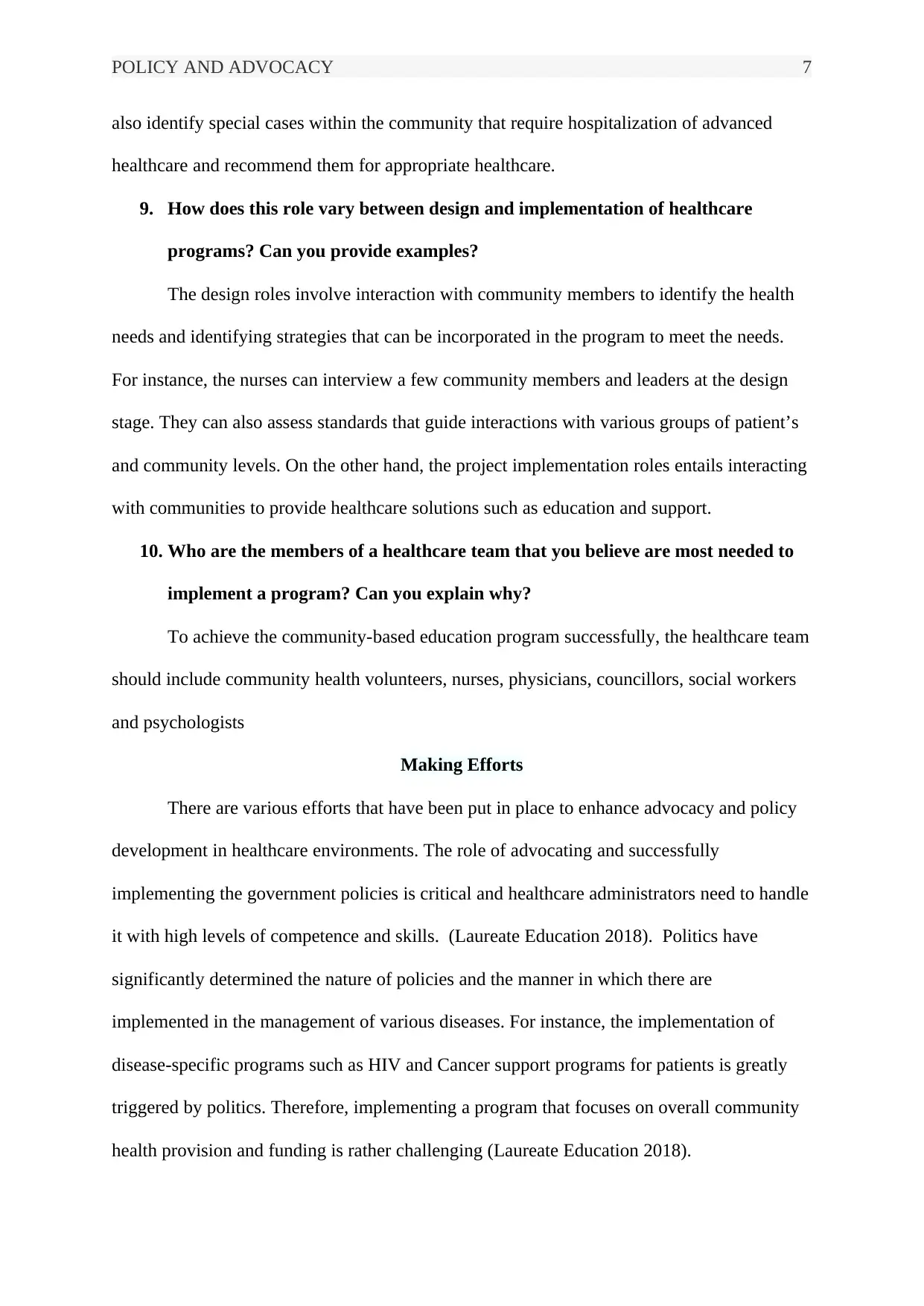
POLICY AND ADVOCACY 7
also identify special cases within the community that require hospitalization of advanced
healthcare and recommend them for appropriate healthcare.
9. How does this role vary between design and implementation of healthcare
programs? Can you provide examples?
The design roles involve interaction with community members to identify the health
needs and identifying strategies that can be incorporated in the program to meet the needs.
For instance, the nurses can interview a few community members and leaders at the design
stage. They can also assess standards that guide interactions with various groups of patient’s
and community levels. On the other hand, the project implementation roles entails interacting
with communities to provide healthcare solutions such as education and support.
10. Who are the members of a healthcare team that you believe are most needed to
implement a program? Can you explain why?
To achieve the community-based education program successfully, the healthcare team
should include community health volunteers, nurses, physicians, councillors, social workers
and psychologists
Making Efforts
There are various efforts that have been put in place to enhance advocacy and policy
development in healthcare environments. The role of advocating and successfully
implementing the government policies is critical and healthcare administrators need to handle
it with high levels of competence and skills. (Laureate Education 2018). Politics have
significantly determined the nature of policies and the manner in which there are
implemented in the management of various diseases. For instance, the implementation of
disease-specific programs such as HIV and Cancer support programs for patients is greatly
triggered by politics. Therefore, implementing a program that focuses on overall community
health provision and funding is rather challenging (Laureate Education 2018).
also identify special cases within the community that require hospitalization of advanced
healthcare and recommend them for appropriate healthcare.
9. How does this role vary between design and implementation of healthcare
programs? Can you provide examples?
The design roles involve interaction with community members to identify the health
needs and identifying strategies that can be incorporated in the program to meet the needs.
For instance, the nurses can interview a few community members and leaders at the design
stage. They can also assess standards that guide interactions with various groups of patient’s
and community levels. On the other hand, the project implementation roles entails interacting
with communities to provide healthcare solutions such as education and support.
10. Who are the members of a healthcare team that you believe are most needed to
implement a program? Can you explain why?
To achieve the community-based education program successfully, the healthcare team
should include community health volunteers, nurses, physicians, councillors, social workers
and psychologists
Making Efforts
There are various efforts that have been put in place to enhance advocacy and policy
development in healthcare environments. The role of advocating and successfully
implementing the government policies is critical and healthcare administrators need to handle
it with high levels of competence and skills. (Laureate Education 2018). Politics have
significantly determined the nature of policies and the manner in which there are
implemented in the management of various diseases. For instance, the implementation of
disease-specific programs such as HIV and Cancer support programs for patients is greatly
triggered by politics. Therefore, implementing a program that focuses on overall community
health provision and funding is rather challenging (Laureate Education 2018).
Paraphrase This Document
Need a fresh take? Get an instant paraphrase of this document with our AI Paraphraser
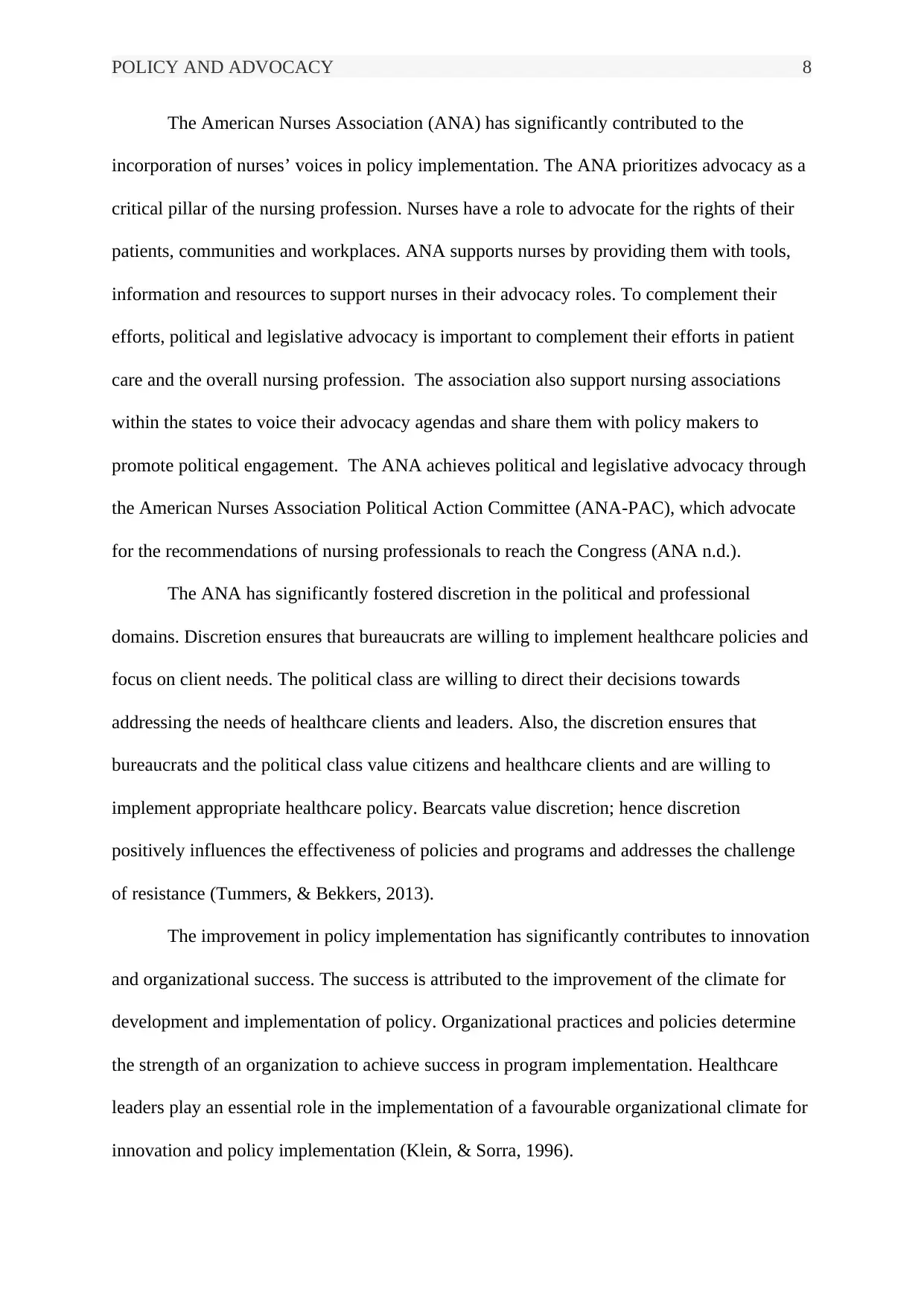
POLICY AND ADVOCACY 8
The American Nurses Association (ANA) has significantly contributed to the
incorporation of nurses’ voices in policy implementation. The ANA prioritizes advocacy as a
critical pillar of the nursing profession. Nurses have a role to advocate for the rights of their
patients, communities and workplaces. ANA supports nurses by providing them with tools,
information and resources to support nurses in their advocacy roles. To complement their
efforts, political and legislative advocacy is important to complement their efforts in patient
care and the overall nursing profession. The association also support nursing associations
within the states to voice their advocacy agendas and share them with policy makers to
promote political engagement. The ANA achieves political and legislative advocacy through
the American Nurses Association Political Action Committee (ANA-PAC), which advocate
for the recommendations of nursing professionals to reach the Congress (ANA n.d.).
The ANA has significantly fostered discretion in the political and professional
domains. Discretion ensures that bureaucrats are willing to implement healthcare policies and
focus on client needs. The political class are willing to direct their decisions towards
addressing the needs of healthcare clients and leaders. Also, the discretion ensures that
bureaucrats and the political class value citizens and healthcare clients and are willing to
implement appropriate healthcare policy. Bearcats value discretion; hence discretion
positively influences the effectiveness of policies and programs and addresses the challenge
of resistance (Tummers, & Bekkers, 2013).
The improvement in policy implementation has significantly contributes to innovation
and organizational success. The success is attributed to the improvement of the climate for
development and implementation of policy. Organizational practices and policies determine
the strength of an organization to achieve success in program implementation. Healthcare
leaders play an essential role in the implementation of a favourable organizational climate for
innovation and policy implementation (Klein, & Sorra, 1996).
The American Nurses Association (ANA) has significantly contributed to the
incorporation of nurses’ voices in policy implementation. The ANA prioritizes advocacy as a
critical pillar of the nursing profession. Nurses have a role to advocate for the rights of their
patients, communities and workplaces. ANA supports nurses by providing them with tools,
information and resources to support nurses in their advocacy roles. To complement their
efforts, political and legislative advocacy is important to complement their efforts in patient
care and the overall nursing profession. The association also support nursing associations
within the states to voice their advocacy agendas and share them with policy makers to
promote political engagement. The ANA achieves political and legislative advocacy through
the American Nurses Association Political Action Committee (ANA-PAC), which advocate
for the recommendations of nursing professionals to reach the Congress (ANA n.d.).
The ANA has significantly fostered discretion in the political and professional
domains. Discretion ensures that bureaucrats are willing to implement healthcare policies and
focus on client needs. The political class are willing to direct their decisions towards
addressing the needs of healthcare clients and leaders. Also, the discretion ensures that
bureaucrats and the political class value citizens and healthcare clients and are willing to
implement appropriate healthcare policy. Bearcats value discretion; hence discretion
positively influences the effectiveness of policies and programs and addresses the challenge
of resistance (Tummers, & Bekkers, 2013).
The improvement in policy implementation has significantly contributes to innovation
and organizational success. The success is attributed to the improvement of the climate for
development and implementation of policy. Organizational practices and policies determine
the strength of an organization to achieve success in program implementation. Healthcare
leaders play an essential role in the implementation of a favourable organizational climate for
innovation and policy implementation (Klein, & Sorra, 1996).
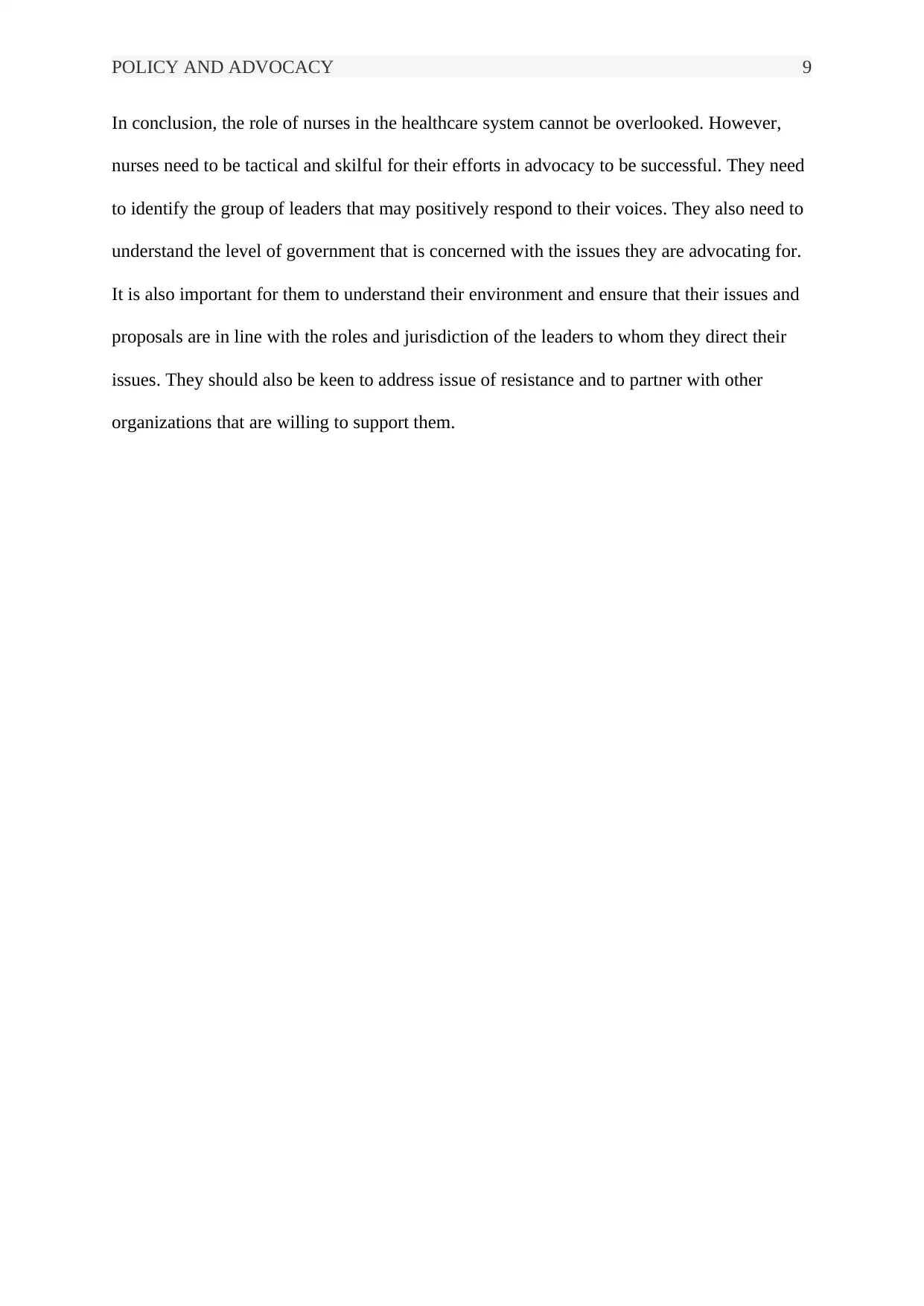
POLICY AND ADVOCACY 9
In conclusion, the role of nurses in the healthcare system cannot be overlooked. However,
nurses need to be tactical and skilful for their efforts in advocacy to be successful. They need
to identify the group of leaders that may positively respond to their voices. They also need to
understand the level of government that is concerned with the issues they are advocating for.
It is also important for them to understand their environment and ensure that their issues and
proposals are in line with the roles and jurisdiction of the leaders to whom they direct their
issues. They should also be keen to address issue of resistance and to partner with other
organizations that are willing to support them.
In conclusion, the role of nurses in the healthcare system cannot be overlooked. However,
nurses need to be tactical and skilful for their efforts in advocacy to be successful. They need
to identify the group of leaders that may positively respond to their voices. They also need to
understand the level of government that is concerned with the issues they are advocating for.
It is also important for them to understand their environment and ensure that their issues and
proposals are in line with the roles and jurisdiction of the leaders to whom they direct their
issues. They should also be keen to address issue of resistance and to partner with other
organizations that are willing to support them.
⊘ This is a preview!⊘
Do you want full access?
Subscribe today to unlock all pages.

Trusted by 1+ million students worldwide
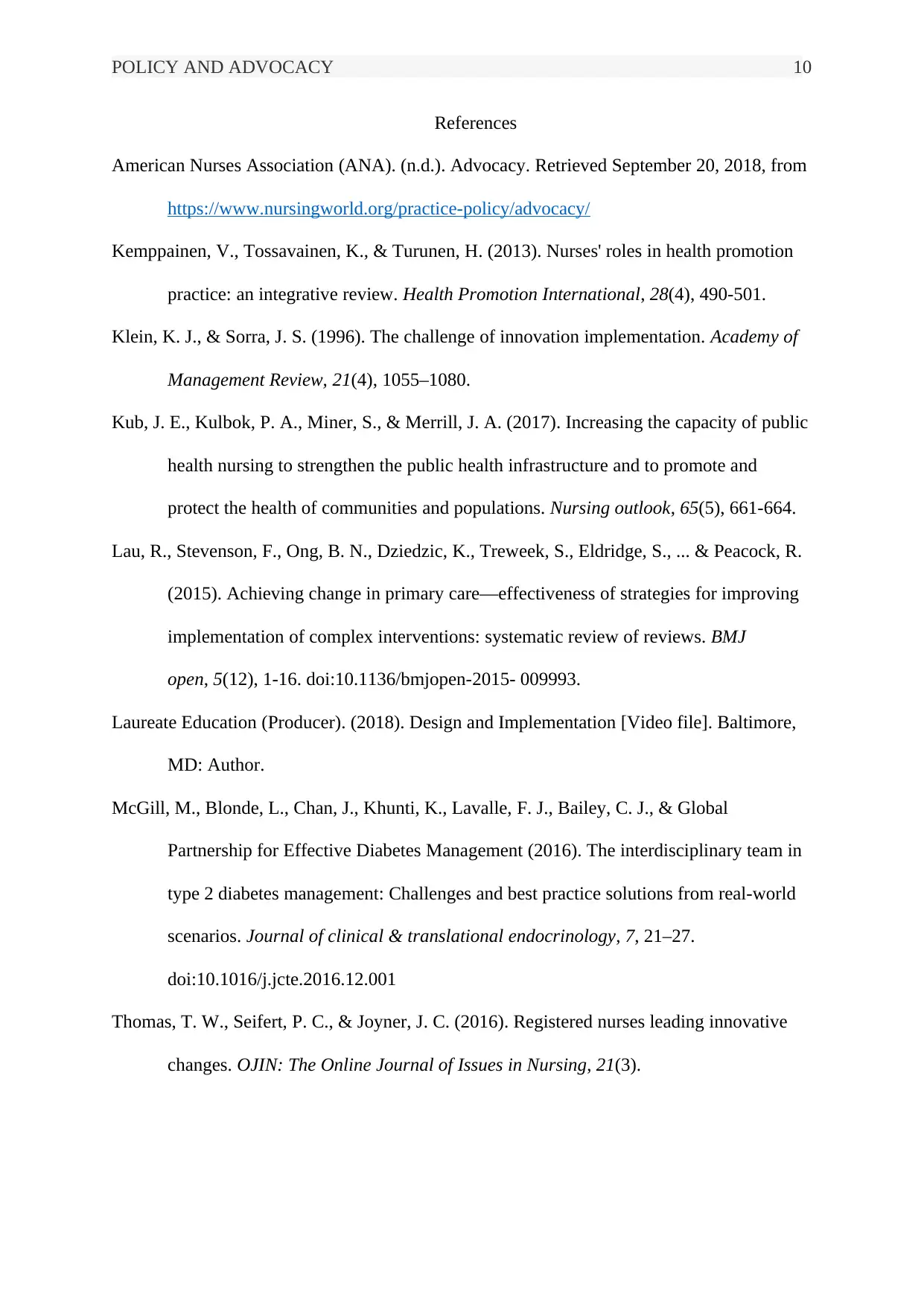
POLICY AND ADVOCACY 10
References
American Nurses Association (ANA). (n.d.). Advocacy. Retrieved September 20, 2018, from
https://www.nursingworld.org/practice-policy/advocacy/
Kemppainen, V., Tossavainen, K., & Turunen, H. (2013). Nurses' roles in health promotion
practice: an integrative review. Health Promotion International, 28(4), 490-501.
Klein, K. J., & Sorra, J. S. (1996). The challenge of innovation implementation. Academy of
Management Review, 21(4), 1055–1080.
Kub, J. E., Kulbok, P. A., Miner, S., & Merrill, J. A. (2017). Increasing the capacity of public
health nursing to strengthen the public health infrastructure and to promote and
protect the health of communities and populations. Nursing outlook, 65(5), 661-664.
Lau, R., Stevenson, F., Ong, B. N., Dziedzic, K., Treweek, S., Eldridge, S., ... & Peacock, R.
(2015). Achieving change in primary care—effectiveness of strategies for improving
implementation of complex interventions: systematic review of reviews. BMJ
open, 5(12), 1-16. doi:10.1136/bmjopen-2015- 009993.
Laureate Education (Producer). (2018). Design and Implementation [Video file]. Baltimore,
MD: Author.
McGill, M., Blonde, L., Chan, J., Khunti, K., Lavalle, F. J., Bailey, C. J., & Global
Partnership for Effective Diabetes Management (2016). The interdisciplinary team in
type 2 diabetes management: Challenges and best practice solutions from real-world
scenarios. Journal of clinical & translational endocrinology, 7, 21–27.
doi:10.1016/j.jcte.2016.12.001
Thomas, T. W., Seifert, P. C., & Joyner, J. C. (2016). Registered nurses leading innovative
changes. OJIN: The Online Journal of Issues in Nursing, 21(3).
References
American Nurses Association (ANA). (n.d.). Advocacy. Retrieved September 20, 2018, from
https://www.nursingworld.org/practice-policy/advocacy/
Kemppainen, V., Tossavainen, K., & Turunen, H. (2013). Nurses' roles in health promotion
practice: an integrative review. Health Promotion International, 28(4), 490-501.
Klein, K. J., & Sorra, J. S. (1996). The challenge of innovation implementation. Academy of
Management Review, 21(4), 1055–1080.
Kub, J. E., Kulbok, P. A., Miner, S., & Merrill, J. A. (2017). Increasing the capacity of public
health nursing to strengthen the public health infrastructure and to promote and
protect the health of communities and populations. Nursing outlook, 65(5), 661-664.
Lau, R., Stevenson, F., Ong, B. N., Dziedzic, K., Treweek, S., Eldridge, S., ... & Peacock, R.
(2015). Achieving change in primary care—effectiveness of strategies for improving
implementation of complex interventions: systematic review of reviews. BMJ
open, 5(12), 1-16. doi:10.1136/bmjopen-2015- 009993.
Laureate Education (Producer). (2018). Design and Implementation [Video file]. Baltimore,
MD: Author.
McGill, M., Blonde, L., Chan, J., Khunti, K., Lavalle, F. J., Bailey, C. J., & Global
Partnership for Effective Diabetes Management (2016). The interdisciplinary team in
type 2 diabetes management: Challenges and best practice solutions from real-world
scenarios. Journal of clinical & translational endocrinology, 7, 21–27.
doi:10.1016/j.jcte.2016.12.001
Thomas, T. W., Seifert, P. C., & Joyner, J. C. (2016). Registered nurses leading innovative
changes. OJIN: The Online Journal of Issues in Nursing, 21(3).
Paraphrase This Document
Need a fresh take? Get an instant paraphrase of this document with our AI Paraphraser
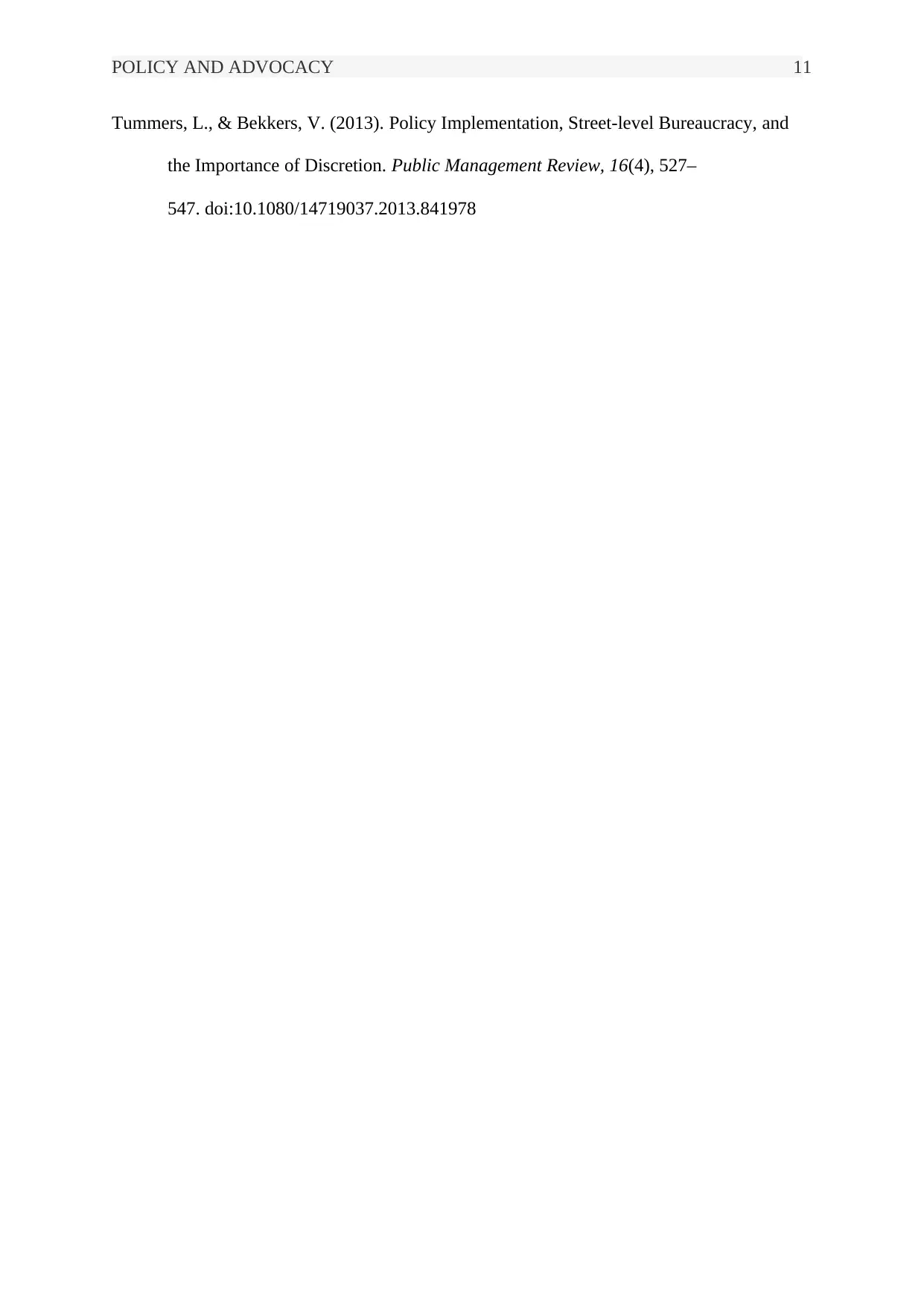
POLICY AND ADVOCACY 11
Tummers, L., & Bekkers, V. (2013). Policy Implementation, Street-level Bureaucracy, and
the Importance of Discretion. Public Management Review, 16(4), 527–
547. doi:10.1080/14719037.2013.841978
Tummers, L., & Bekkers, V. (2013). Policy Implementation, Street-level Bureaucracy, and
the Importance of Discretion. Public Management Review, 16(4), 527–
547. doi:10.1080/14719037.2013.841978
1 out of 11
Related Documents
Your All-in-One AI-Powered Toolkit for Academic Success.
+13062052269
info@desklib.com
Available 24*7 on WhatsApp / Email
![[object Object]](/_next/static/media/star-bottom.7253800d.svg)
Unlock your academic potential
Copyright © 2020–2025 A2Z Services. All Rights Reserved. Developed and managed by ZUCOL.





